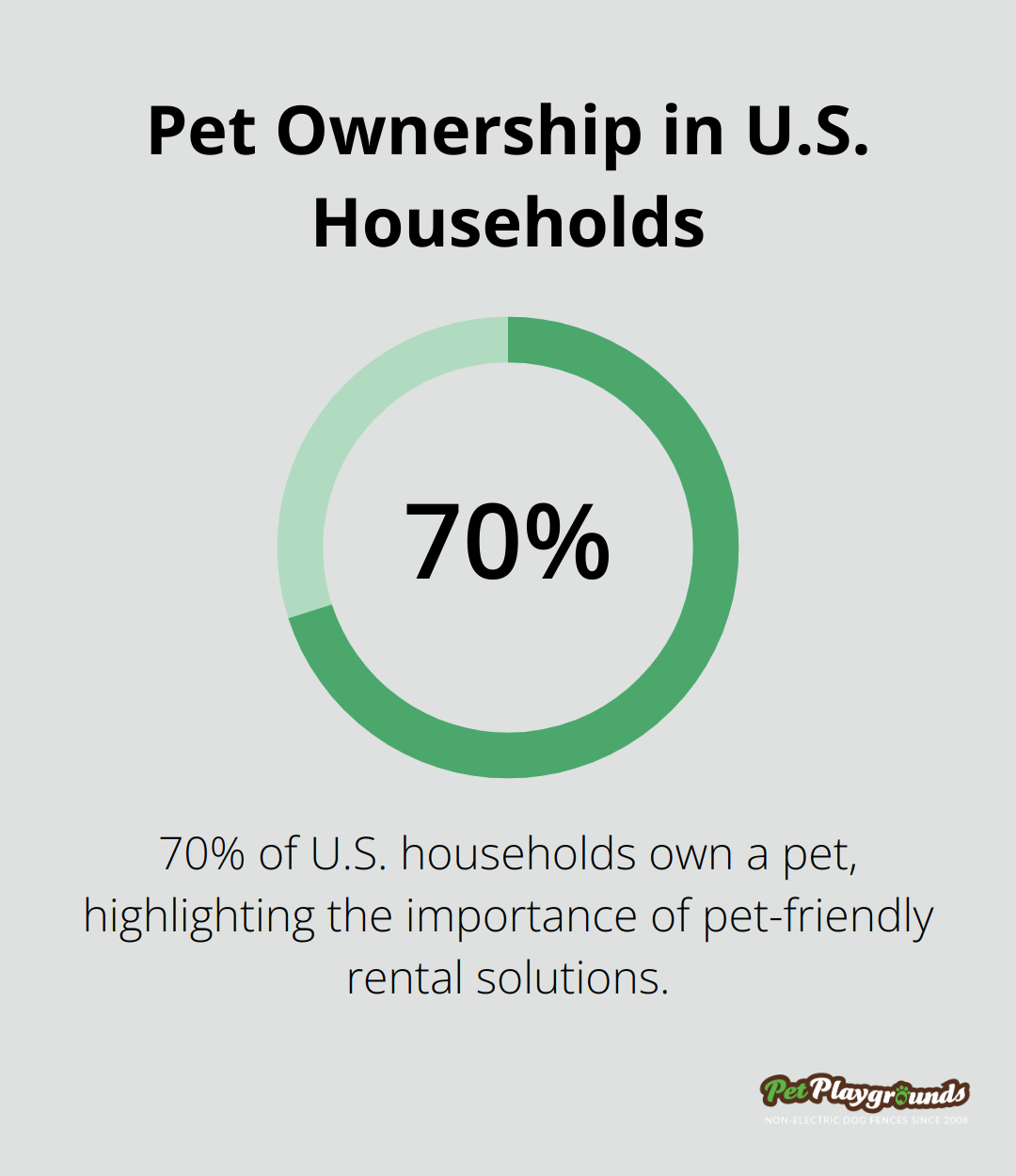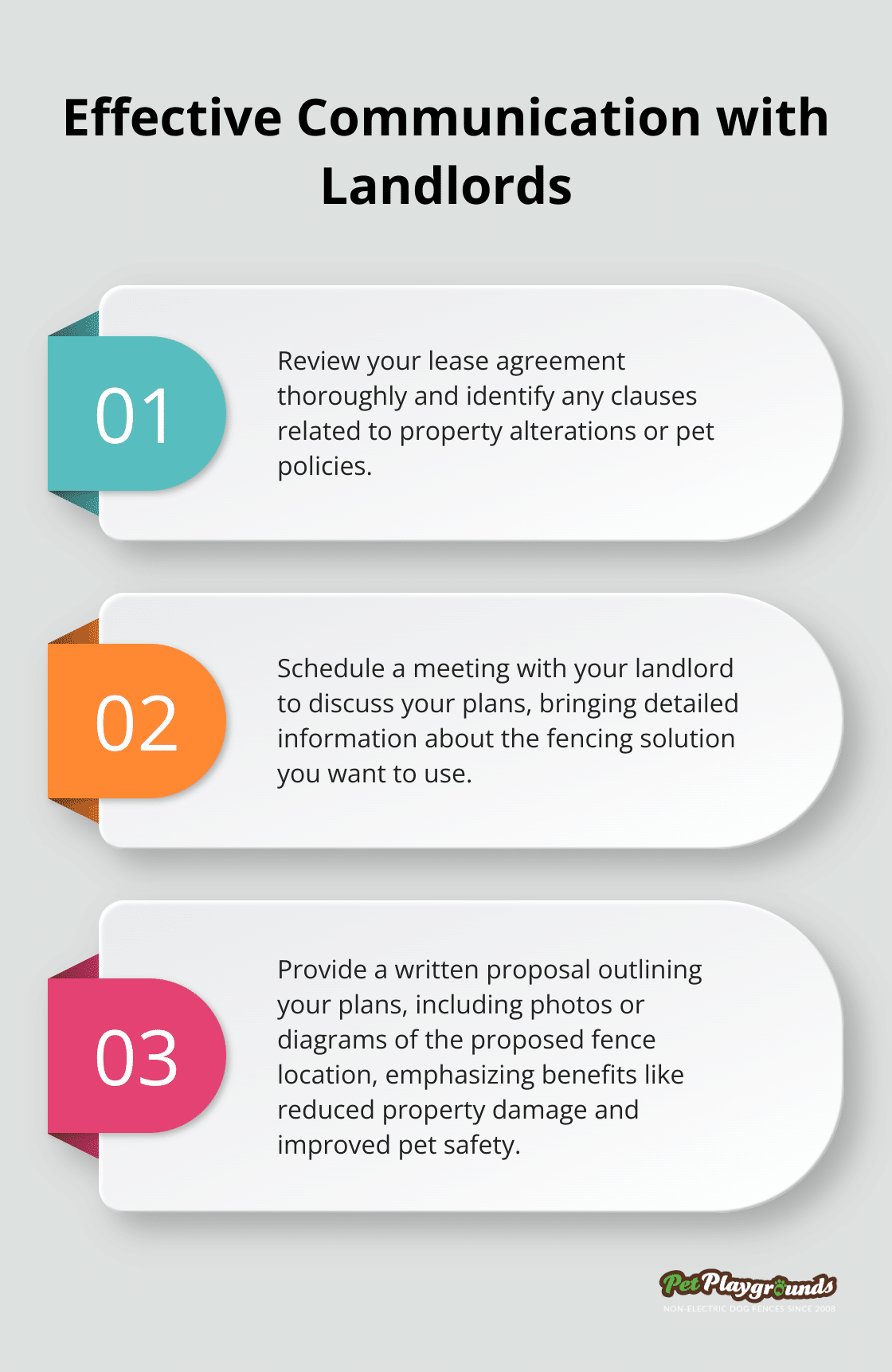Renting with pets can be challenging, especially when it comes to creating safe outdoor spaces. At Petplaygrounds Non Electric Dog Fence, we understand the unique needs of pet owners in rental properties.
This guide explores temporary fencing solutions that keep your furry friends secure without violating lease agreements. We’ll cover legal considerations, top fencing options, and tips for maintaining a positive relationship with your landlord.
What Are Temporary Pet Fences for Renters?
Definition and Purpose
Temporary pet fences are portable, non-permanent enclosures that create safe outdoor spaces for pets in rental properties. These fences offer a practical solution for renters who want to give their pets freedom to roam without violating lease agreements or damaging property.
Types of Temporary Fencing Options
Several temporary fencing options cater to different needs and preferences:
- Portable mesh fences: Lightweight and easy to set up, ideal for frequent movers.
- Free-standing pet gates: Flexible barriers for yards or patios.
- Outdoor playpens: Compact solutions for smaller spaces.
- Non-electric dog fence systems (like Pet Playgrounds): Combine durability with easy installation, using strong poly mesh and steel cables.
Benefits for Renters with Pets
Temporary pet fences provide numerous advantages:
- Create safe outdoor areas for pet exercise and play
- Reduce the risk of pet escape or wildlife encounters
- Alleviate stress for both pet owners and landlords
- Allow compliance with lease requirements while providing essential outdoor access
A 2022 survey by the American Pet Products Association found that 70% of U.S. households own a pet. For renters in this group, temporary fencing can significantly improve their living situation.

Installation and Removal Considerations
The ease of installation and removal is a key benefit of temporary pet fences. Most options don’t require digging or permanent fixtures, which preserves the integrity of the rental property. This feature appeals to landlords who may hesitate to allow permanent alterations.
When selecting a fence, consider:
- The size and behavior of your pet
- Fence height (to prevent jumping or climbing)
- Sturdiness (for larger or more active dogs)
Cost-Effective Pet Management
Temporary fencing offers a cost-effective way to manage pets in rental properties. Prices typically range from $50 to $400 (depending on size and type). This investment can potentially save money by:
- Preventing property damage
- Avoiding pet-related disputes with landlords or neighbors
- Reducing the risk of pet-related incidents
As we move forward, it’s important to understand the legal considerations that renters must navigate when installing temporary pet fences. Let’s explore the key aspects of lease agreements, landlord communication, and local regulations that impact your fencing decisions.
Navigating Legal Waters for Temporary Pet Fences
Understanding Your Lease Agreement
Before you install any temporary pet fence, you must review your lease agreement thoroughly. Many leases include specific clauses about property alterations, even temporary ones. Search for sections that address outdoor modifications, pet policies, and restrictions on installing structures. If your lease lacks clarity, don’t assume permission. Contact your landlord or property manager for clarification.
Effective Communication with Your Landlord
Open dialogue with your landlord is essential when you consider a temporary pet fence. Schedule a meeting to discuss your plans and bring detailed information about the fencing solution you want to use. Landlords often respond more positively when presented with specifics about temporary dog fences, installation methods, materials, and removal processes.
Emphasize the benefits of temporary fencing, such as reduced property damage and improved pet safety. Provide a written proposal that outlines your plans, including photos or diagrams of the proposed fence location. This level of preparation shows your commitment to responsible pet ownership and property respect.

Navigating Local Regulations
Local laws and homeowners’ association (HOA) rules can affect your ability to install temporary fencing. Research your area’s zoning laws and any specific ordinances related to pet containment. Some municipalities enforce height restrictions or require permits for certain types of fencing (even temporary ones).
If you live in an HOA-governed community, review the association’s bylaws carefully. HOA rules often enforce strict guidelines about exterior modifications, including temporary structures. Violation of these rules could result in fines or legal issues.
Compliance with local regulations isn’t just about avoiding penalties; it’s about being a responsible community member and maintaining good relationships with neighbors. When you adhere to local rules, you increase your chances of gaining support for your pet-friendly modifications.
Legal Considerations for Different Fencing Types
Different types of temporary fencing may face varying legal challenges. For example, portable mesh fences might require less scrutiny than more substantial structures. Free-standing pet gates could fall under different regulations than outdoor playpens. Non-electric dog fence systems (like those offered by Pet Playgrounds) might need specific approvals due to their more permanent nature.
Understanding these nuances can help you choose the most legally viable option for your situation. Always consult with your landlord and local authorities before making a final decision on your fencing solution.
As we move forward, let’s explore the top temporary fencing solutions available for renters, taking into account the legal considerations we’ve discussed.
Best Temporary Fencing Options for Renters in 2025
Non-Electric Dog Fence Systems
Pet Playgrounds Non-Electric Dog Fence offers a premium solution for renters who want a secure and visually appealing option. This system provides four levels of security, including a chew-deterrent poly mesh (infused with Spicy Pro) and strong steel cable rails. The fence’s dig guard and anti-climb design protect against wildlife, making it suitable for areas with coyote concerns. Installation doesn’t require concrete or extensive labor, and the system adapts to existing landscapes. Financing options under $5 per day make it accessible for many renters.

Portable Mesh Fences
Portable mesh fences provide flexibility and ease of use. These lightweight barriers typically come in panels that users can quickly assemble and disassemble. When choosing a mesh fence, try to find UV-resistant materials to ensure longevity in outdoor conditions. Some models include reflective strips for improved visibility at night, which enhances safety for both pets and passersby.
Free-Standing Pet Gates
Renters with patios or small yards can benefit from free-standing pet gates. These gates don’t require attachment to walls or fences, which makes them ideal for temporary use. Models with wide bases provide stability, especially for larger or more energetic pets. Some gates feature expandable designs, allowing users to adjust the width to fit various spaces.
Outdoor Playpens
Outdoor playpens offer a compact solution for renters with limited space. These enclosures come in various sizes and materials, from lightweight fabric to sturdy metal. Playpens provide a controlled environment for pets to exercise and play safely. Many models fold flat for easy storage and transport, which makes them perfect for renters who move frequently.
Temporary Electric Fences
While not suitable for all situations, temporary electric fences can provide an invisible barrier for pets. These systems use a collar that emits a warning sound or mild static correction when the pet approaches the boundary. Renters should note that these systems require training and may not be appropriate for all pets or living situations. Always consult with your landlord before installing any electric system, even if it’s temporary. The American Kennel Club notes that GPS fences, such as SpotOn, are now available as an alternative to traditional electric fences, offering an easy and reliable way to contain your dog using patented True Location™ technology.
Final Thoughts
Temporary pet fences provide renters with practical solutions to create safe outdoor spaces for their pets. These fencing options, including the Pet Playgrounds Non-Electric Dog Fence, offer peace of mind while respecting rental property constraints. Renters should prioritize sturdy materials, appropriate heights, and secure designs to prevent escapes and protect pets from potential hazards.
Open communication with landlords proves essential for successful temporary fencing arrangements in rental properties. Presenting clear plans, addressing concerns, and emphasizing the benefits of contained pets often leads to approval for fencing solutions. This proactive approach fosters positive relationships and may result in more pet-friendly policies in the future.
Temporary pet fences represent a mutually beneficial solution for tenants and property owners in the evolving rental landscape. These fences allow pet owners to provide their animals with outdoor access while respecting rental living constraints (and maintaining property integrity). Careful selection of the right fencing option and proper installation procedures create a harmonious living environment that keeps pets safe and landlords satisfied.



![Can Renters Install Temporary Pet Fences? [2025 Guide]](jpg/rental-property-1752455293-1170x694.jpg)




















